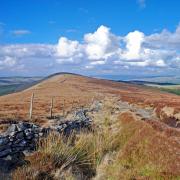Understanding wildlife in our hectic, modern world is often complicated and in some cases may even require a knowledge of industrial history.
This connection to our past was brought home to me recently when I took a stroll along a fogbound track bordering the River Trent.
As I peered through the dense mist I realised my ears were far more effective than my eyes and, because I was spending so much time looking down to make sure I didn't slip into the river, I was, as a birdwatcher, not really spotting anything.
Suddenly, as I gingerly walked on, the air was punctured by a loud, penetrating 'klee, klee, klee' from a flying bird.
I couldn't see it but I could almost taste and smell the salty sea air because I instantly knew that the bird was an oystercatcher.
Yet I was in the most distant county from the coast, completely landlocked, so what was a bird which is adapted to eating cockles and mussels doing so far from home?

The answer is linked to our industrial history and, in this case, the extraction of sand and gravel.
At the end of the last ice age as the enormous glaciers melted away and retreated north, they dumped huge deposits of sand and gravel in a number of places.
Some of them were redistributed by the mighty rivers which followed and some of those rivers, like the Trent, are still with us today.
What they left, particularly in the regions around the Trent, were two types of exploitable deposits, one in the river bed and another buried below relatively thin layers of soil.
The ever resourceful Romans discovered these deposits and became the first people to work them, mainly using the sand for mortar.
During the Medieval period, many small pits were worked on a minor scale but this started to increase in the 17th and 18th centuries as demand for gravel for the drives of large, imposing country houses became fashionable.
As the centuries rolled by the demand for both sand and gravel continued to rise dramatically and by the 1930s the dredging of the River Trent was beginning to cause concern, and consequently most production was switched to land-based deposits such as at Hilton, Swarkestone and Willington in Derbyshire.

Some of these are known as wet deposits because the gravel is below the water table. Originally, these deposits were wet dredged until powerful pumps were developed so that the gravel could be extracted 'dry', which was far better because the quarry workers could see the deposit and consequently keep it much cleaner.
Extraction increased once again during the Second World War as the demand for concrete for runways, air raid shelters, bunkers and gun emplacements increased.
The post war period saw further major increases in demand due to a huge building programme of coal-fired power stations (such as the one found at Willington), road building (as we turned from trains to cars) and house building, particularly council houses.
By the year 2000 annual sand and gravel production in the UK was an incredible 200 million tons and a significant amount of that was extracted from the many quarries around the Trent here in Derbyshire as well as Nottinghamshire.
Since then, extraction has declined slightly as crushed stone has replaced some of the previous demand.
Up until the 1980s most of the abandoned sand and gravel quarries were back-filled and restored to farmland.
However, since that date we've started to realise that we don't really need more farmland and there are now much more pressing demands, particularly for nature and recreation.
The 2000 Derby and Derbyshire Minerals Local Plan states that 'all new proposals will be permitted only where satisfactory provision has been made for the reclamation and after-use of the site as soon as possible.'
That after-use now has to include nature, landscape and recreational enhancement. These plans also have to fit alongside local initiatives such as the 'On Trent' project, which is addressing the needs to benefit the local community and reverse the decline in local biodiversity.
So, on that misty morning when I was rudely hailed by an oystercatcher, I knew exactly why it was there.
That vision to switch from reclaiming exhausted sand and gravel sites into boring, grassy fields to wetland oases such as those at Willington, Drakelow and Hilton was absolutely brilliant.

This subsequent increase in wetland sites produced new opportunities, not just for new colonists like oystercatchers and shelduck, but for declining, and in some cases, incredibly rare birds such as bitterns.
Oystercatchers have always struck me as the least plausible of inland invaders. Granted the reclaimed sand and gravel works often have sandy shores which may seem familiar to the birds but they definitely don't have cockles and mussels living in their shallow waters.
However, if you watch oystercatchers at the seaside you often find them feeding avidly on the farmland behind the dunes.
Here their long, incredibly powerful orange bills are used to stab into the moist soil and extract, very effectively, earthworms.
This is ultimately the key to their successful transformation inland. Another factor that has played into their hands has been the building in the past 100 years of a number of reservoirs.
These often have stony banks which provide ample nesting places. In the area that I often walk in - the local reservoirs around Bradfield on the western boundary of the Peak Park - I now regularly encounter a number of oystercatchers.
Their loud call is diagnostic and there is absolutely no mistaking that incredible black and white plumage and distinctive orange bill.
I still think of them as sort of 'out of place' but I love them all the more for that.



























